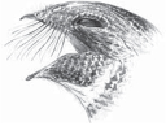Biology Reference
In-Depth Information
The feathers around the mouths of Whip-poor-wills, called
semibristles
, have a tactile
function similar to that of a cat's whiskers and may also increase the useful area of the
gape for sweeping up insects.
Q Can birds really feel barometric pressure?
A
We have an abundance of field data that implies that birds must be able to feel ba-
rometric pressure. Before storms, as pressure is falling, birds feed more actively than at
other times. During nocturnal migration or in foggy conditions, birds can maintain a safe
altitude for long distances without being able to see or visually gauge the distance to the
groundbeneaththem.Bothoftheseabilitiesseemtodependonbeingabletodetectbaro-
metricpressure,butscientistshaven'tyetbeenabletodiscoverexactlyhowbirdsdothis.
However, scientists have proven experimentally that homing pigeons are extremely sens-
itivetosmallchangesinairpressure,comparabletoabouta25-footdifferenceinaltitude.
Q Do birds have any senses that we humans lack entirely?
A
Many birds can sense the earth's magnetic pull and use this information to help them
navigate. In one experiment, scientists fitted homing pigeons with tiny metal helmets.
Half of the birds wore magnetic helmets of iron and the other half wore helmets made of
anonmagneticsubstanceofthesameweight.Thebirdsweretakenawayfromtheirhome
loft and released.
The pigeons with magnetic helmets usually became lost on cloudy days, probably be-
cause the helmet interfered with their ability to perceive the earth's magnetic field, which
they use to help them navigate when they can't see the sun. (When the sun came out, pi-
geons with magnetic helmets found their way home, too.)
Tiny crystals of magnetite have been found near the olfactory nerves of pigeons
between their eyes, and magnetite has also been found in similar tissues or the upper
beaks inmany migratory species. Inarecent experiment, scientists trained caged pigeons
to hop to one end of their cage when the magnetic field was normal and to the other end
when the scientists switched to an abnormal magnetic field. The birds could only learn
this task if, indeed, they could detect differences in the magnetic field.
When scientists attached magnets to the pigeons' upper beaks, the birds could no
longer perform the task. And when scientists temporarily froze their olfactory cavity






